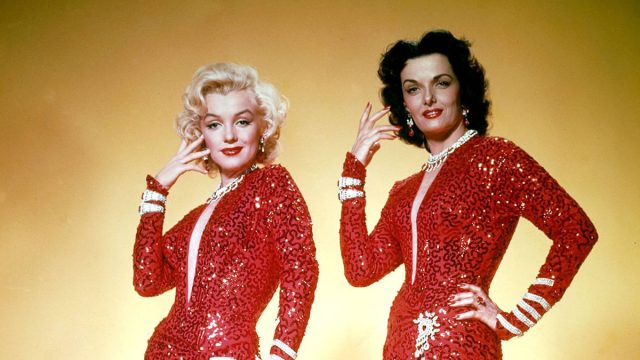Gentlemen Prefer Blondes: The Intimate Diary of a Professional Lady was a light comic trifle of a novel, built by Anita Loos from some Harper’s Bazaar features and published in 1925. (The Tales of the City of its time, I suppose.) It was adapted into a successful stage musical in 1949, launching the career of Broadway legend Carol Channing (and in an earlier, lost film.)
It was probably inevitable that someone would try to turn Gentlemen into a movie musical, but even in the golden age of the genre, success was hardly guaranteed. (Ever heard of Cruisin’ Down the River?’ Me neither, until I was checking Wikipedia to make sure I wasn’t talking out of my ass.) A lot of elements led to the movie’s success, but I’d argue the top factor was its casting. For the female leads, producer Sol Siegel tapped up-and-coming starlet Marilyn Monroe (who was paid her usual $500 a week salary) and Jane Russell, a Hollywood sex symbol at the height of her powers (her total salary was $200,000). The two women were charismatic, sexy, and decent singers with crack comic timing. But perhaps most importantly, Russell and Monroe genuinely seemed to like one another. They have good old-fashioned chemistry, and the friendship between their two characters feels supportive and real. While there’s some “smart brunette, dumb blonde” energy going on, Lorelei is also smarter and savvier than she usually purports to be (“I can be smart when it’s important, but most men don’t like it.”)
Girls of a certain age (it’s me, I’m girls) didn’t grow up with a lot of media that focused on female friendship, and when we found it, it was usually within the pages of books. Stories on screen tended to suffer from the Smurfette problem; every narrative had exactly one female character, whether the show needed it or not. Sometimes they’d get fancy, and give you a Daphne and a Velma, but their friendship rarely took center stage. For those of us who grew up in this environment, every glimpse we had of another world, a better world, with girls who liked each other and talked to each other regularly, was a real treat; it’s probably one of the reasons Joss Whedon and Buffy got as much leeway as they did over the years.
Gentlemen Prefer Blondes is a delightful exception to decades of male-dominated media, showing two women who’ve known each other from childhood, escaped rural Arkansas together, and are now determined to find love and riches, not necessarily in that order. They accept each other as they are — though they’re certainly not above giving unsolicited advice — and never compete in romance (though that may be because Russell puts money a little lower on her list than Monroe). Their mutual support is the emotional core of Gentlemen Prefer Blondes; the movie all but grinds to a halt in one of the final scenes so Jane Russell can underline to love interest Elliot Reid that she would never, ever betray her best friend.
The rest of the movie works just fine, too. Monroe and Russell also get some fantastic showpieces, including Monroe’s immortal, often-homaged performance of “Diamonds Are a Girl’‘s Best Friend” and Russell’s wry “Ain’t There Anyone Here for Love?” (which even earned its own pop culture homage).” The songs are catchy, the lyrics are clever, and Russell’s romance with Reid is a sweet partnership between near-equals. (And if you haven’t seen the movie yet, Russell’s Monroe impersonation alone is worth the watch.)
Of course, the greatest cultural impact the movie has made is “Diamonds Are a Girl’s Best Friend,” a song and performance so iconic that Wikipedia has an entire section devoted to homages and parodies. (I don’t know if it’s a coincidence that the titular Bridesmaids’ loud pinkdresses are an almost identical shade to Lorelei Lee’s “Diamonds” dress, but it certainly resonated with me.) But you’ll see the echoes of Lorelai and Dorothy’s friendship in the snappy dialogue of The Golden Girls and even in those direct-to-video Barbie movies. Sisters before misters, indeed.


